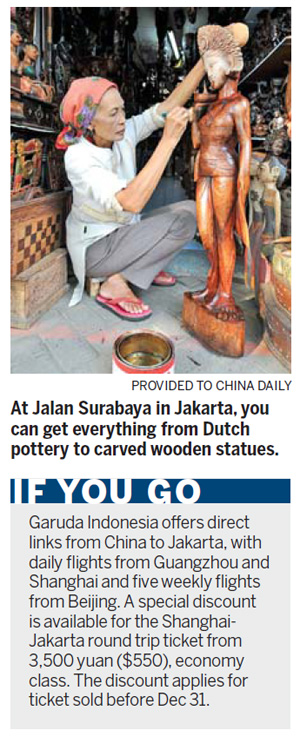Straight to the heart of Indonesia
Updated: 2011-12-04 08:10
By Li Jing(China Daily)
|
|||||||

As our Garuda flight gradually banks and glides in to land, the shimmering sea sprawls below us. The sunshine glitters on the dazzling blue and the islands dot the broad expanse of sea like little gems.
Although Jakarta does not regard itself as a major tourist attraction in a country with exquisite sun, sea, sand to offer, it does offer a microcosm of what you can expect, from traditional batiks to Balinese carvings to ancient Javanese puppets.
For a step back into the past, head for Jalan Surabaya in Jakarta's posh, leafy Menteng neighborhood, where an open-air market holds together fragments of fading history.
It has several long aisles of stalls and it is hard to define exactly what is on sale. There are dishes spirited from sunken ships, blue-and-white pottery originally made in Holland, Bakelite radios, old Rolleiflex cameras, Javanese puppets, bulbous masks, ships' lanterns, glass chandeliers, magic knives, elegant rotary phones and wooden statues.
In the neighborhood is another shop for some of the best Indonesian souvenirs - a batik boutique by Iwan Tirta, Indonesia's foremost batik designer.
Batik, one of the country's most highly developed art forms, is also a national heritage. The word batik comes from "ambatik" which translates to "cloth with little dots".
At the shop, Iwan Tirta sells both clothes and lengths of cloth from several Indonesian islands.
Original designs are sold for about $12-$15 each, a great value.
Jakarta is much more of a modern metropolis than I expected, with soaring skyscrapers anchored by high-end shopping malls and five-star hotels.
But much of the city is also packed with humble wooden shacks and villages, and they often fringe the high-rise flyovers that dissect the city.
A river runs right through, with its banks populated by shantytowns where migrant workers live.
Like most densely populated cities, traffic is often at snail speed, clogged by vans, buses, cars and a motorcycle brigade that suffocates the streets.
Because of the high housing prices downtown, most Jakarta citizens live in the suburbs and commute into work every day.
The grid-locked streets have given rise to an unusual sight.
At peak hours, you can see people waiting by the curbs, looking for cars that stop and pick them up. They get a free ride, and they get paid.
That's because private car owners must have four passengers in the car at rush hours or they will be fined.
These professional "riders" boost the numbers, the drivers breeze through the checkpoints and everyone's happy.
Pregnant women are the most popular pick-ups. They count for two, our guide says.
You may contact the writers at lijing2009@chinadaily.com.cn.
China Daily
(China Daily 12/04/2011 page16)